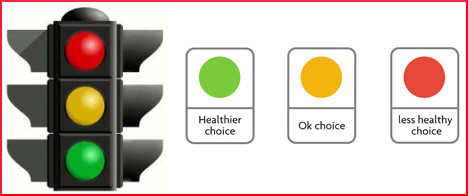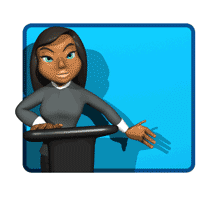 Right: The traffic light system explained: guidelines for parents emphasize healthy foods by colour-coding.
Right: The traffic light system explained: guidelines for parents emphasize healthy foods by colour-coding.
 Found a word you're not familiar with? Double-click that word to bring up a dictionary reference to it. The dictionary page includes an audio sound file with which to actually hear the word said. Found a word you're not familiar with? Double-click that word to bring up a dictionary reference to it. The dictionary page includes an audio sound file with which to actually hear the word said. |
 Background information
Background information
School lunchbox guidelines for parents
All Australian states and territories supply guidelines to assist parents and guardians in the preparation of school lunches for their children. Western Australia appears to have the most detailed and prescriptive set of guidelines. It begins by dividing foods into four groups from each of which parents should select. These are bread and cereals; fruits and vegetables; reduced fat dairy, meat, and alternatives; and snacks. Examples are given as to what can be selected from each group. Within the snacks category the options are dried fruit, pikelets, plain rice crackers, cheese and crackers, dips (tzatziki and hummus), and plain popcorn.
The Western Australian guidelines then give more specific advice, following what is termed a traffic light system. Foods are classified as 'green' meaning they should constitute 60 percent of what is eaten, as 'orange' meaning they should constitute 40 percent of what is eaten, or as 'red' meaning they should not be consumed at all. Included on the 'red' list are full-fat pastry items; sweet sandwich fillings including jam, nut spreads and honey; and high fat sandwich meats including polony and salami. Soft drinks, cordial, sports drinks, and fruit juice are also excluded.

In Victoria, school lunchbox advice is presented in a pic'n'mix format, with parents being advised to select from six groups - fruit (fresh, frozen, pureed and canned in natural juice); vegetables, legumes and beans; milk, yoghurt, cheese and alternatives; lean meats and poultry, fish, eggs, tofu, nuts and seeds, and legumes and beans; grain (cereal) foods; and plain water.

Victoria also follows a traffic light system which specifies fewer items than Western Australia's. Included in the Victorian 'red' list are pies and sausage rolls, Devon, salami and Strasburg sandwich meats and biscuits, cakes, slices, and sweet pastries.

South Australia's lunchbox advice is very similar to Victoria's except five groups are offered from which to make a choice. Water is later recommended as the only appropriate drink - pack plain water to drink, such as tap, spring, mineral, soda and sparkling waters, instead of sugary drinks like soft drink, fruit juice drink or flavoured milk. South Australia also makes allowance for some discretionary foods such as 'cakes, lollies, sweet biscuits and chips.' Parents are advised regarding these: 'Try to avoid them all together. If you have them, include only occasionally and in small amounts.'
 South Australia also follows a traffic light system. Included in the 'red' category are soft drinks, artificially sweetened soft drinks, energy drinks, sports drinks, flavoured mineral waters, sports waters, and fruit drinks. The 'red' category also includes pasta meals, pizzas, baked potato products, dim sims, fried rice and noodles, crumbed and coated foods, frankfurts and sausages.
South Australia also follows a traffic light system. Included in the 'red' category are soft drinks, artificially sweetened soft drinks, energy drinks, sports drinks, flavoured mineral waters, sports waters, and fruit drinks. The 'red' category also includes pasta meals, pizzas, baked potato products, dim sims, fried rice and noodles, crumbed and coated foods, frankfurts and sausages. 
New South Wales
 and Queensland
and Queensland  offer similar, though less specific advice and give directions as to how nutritious lunches can be prepared.
offer similar, though less specific advice and give directions as to how nutritious lunches can be prepared. The Australian Capital Territory also follows a similar traffic light system in regulating what foods school canteens sell and advising parents on what should be in children's lunchboxes.

The guidelines supplied in the Northern Territory appear to be among the least prescriptive. They are published under 'Tips for parents' on the Northern Territory Education Department's School Nutrition and Healthy Eating site.

Variations and school autonomy in the application of food guidelines
The degree of rigor with which these guidelines are promoted and monitored appears to vary across schools. Western Australian School Canteen Association executive officer, Megan Neeson, has explained that it is difficult to find a uniform strategy for all schools to follow, and there continue to be differing ways in which the traffic light policy is implemented in Western Australia. Ms Neeson stated, 'Lunchboxes and what parents choose to send from home are not included in the scope of the [Department of Education's] Healthy Food and Drink policy. It is a school-based decision if they choose to look at lunchboxes and provide feedback to parents.'

The traffic light strategy and other similar guidelines appear to have been developed primarily to regulate school canteens and the foods they stock and sell to students. Similar nutrition standards have also been developed to guide early education and childcare centres in the provision of food to preschoolers.
A 2017 Deakin University study of preschool and school meals policies stated of Australia 'National voluntary guidelines (based on the Australian Dietary Guidelines) have been published to guide States and Territories in developing healthy school food provision policies. From these, each State and Territory has developed a set of independent healthy canteen guidelines. Seven States and Territories have implemented mandatory standards based on their guidelines.'
Almost all States and Territories identify 'red category' foods, which are either completely banned in schools or heavily restricted. Guidelines are generally mandatory for government schools in each State or Territory and are highly encouraged for Independent and Catholic schools. New South Wales does not have a 'red' category and instead terms high fat or high sugar foods 'occasional' foods which are allowable in a balanced diet.

The monitoring of and compliance with policy guidelines in schools varies across States and Territories. In general, the policies are not actively enforced or routinely monitored by government. There is variable implementation across the different jurisdictions and poor rates of adherence.

Some school actions that have provoked parental complaints
Actions that some Australian parents have complained about include the confiscation of food items packed by parents and their return to the children at the end of the day.

Parents have also objected to notes being sent home with their children challenging the nutritional value of the food given the child for lunch. Some of these notes have been condemned as 'condescending'.

Parents have further objected to teachers making inaccurate assessments of the food the child has been given. For example, mistaking the nature of some backed goods.

Parents have also objected to the contents of school lunchboxes being criticised when the school canteen sells similar items.

